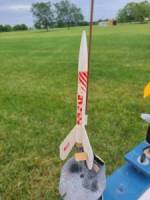Estes Pulsar
By Jeff Curtis
Published: 2024-07-07
| Construction Rating: | starstarstarstarstar |
| Flight Rating: | starstarstarstar_borderstar_border |
| Overall Rating: | starstarstarstarstar_border |
This is a 13mm minimum diameter rocket. I discovered this rocket when I set a goal of building all the rockets in the 1989 Estes Catalog. While not officially part of the Mini Brute series several rockets in the 1989 catalog fit perfectly with the other Mini Brutes. The Pulsar is one of these kits. Not often seen it shows up for sale once in a while.
5" BT-5 body tube
13mm motor block
Balsa die-cut fins
PNC-5A nose cone
Rubber band shock chord
Launch Lug
Engine spacer tube
Waterslide decals
One thing about the kits from 1989, the fins are die cut. Makes me appreciate the switch to laser cut.
I started by cutting out the fins. The lines are not easy to see with die-cast balsa, but I managed to get all three free with no mishap. I then put some Titebond II in one end of the body tube and inserted the motor block. You then use the spacer to push the motor block into the tube, leaving it so a 1/4" of the motor will extend out the end of the tube. Next I cut out the fin marking guide from the instructions and marked the body tube for the three fins. I use Aileen's tacky glue for fins. It really is tacky and holds the fins in place well. I waited about 30 minutes between fins and soon had all three in place. Titebond II fillets were then added, All that was left was the shock cord. I switched the short rubber band cord out for some 100lb. Kevlar. Unfortunately, with a minimum diameter rocket there is no motor mount tube to attach the Kevlar to, so I cut out the tri-fold paper anchor. I used Titebond white glue to glue the shock cord anchor into the body tube. The nose cone is made up of two parts. I did not glue the base into the nose cone until I was sure I didn't need to add weight. No weight was needed so I glue the 2 nose code pieces together and attached the shock cord with a clinch knot.
The paint scheme couldn't be easier, all white. Once painted, I applied the decals. Fortunately, even though from 1989, the decals were still in good shape and I had no trouble applying them. I applied a coat of Minwax polyurethane to seal the decals and was ready for the next launch.
For the maiden flight I selected a 1/2A3-4T. It zipped off the pad and I quickly lost site of it as it did its best impersonation of a Mosquito. Fortunately, another club member had a rocket land about 10' from where the Pulsar ended up. It was a pleasant surprise when he returned it to the LCO station.
Although intended for tumble recovery, I took it home an immediately added a stream for visibility. It's a tight fit as the paper shock cord anchor takes up room in the already small 13mm body tube. I also ordered some 1/4A motors for future launches. I cannot image using a full A if you want any hope of getting this one back.
This kit makes a nice diversion when waiting on glue to dry on larger projects. It would be pretty easy to clone. The plans are available on the JIMZ plans site. I tend to fly my BT-5 rockets when it's too windy for the bigger parachute rockets.
Estes Pulsar Reviews
Sponsored Ads
 |
 |













